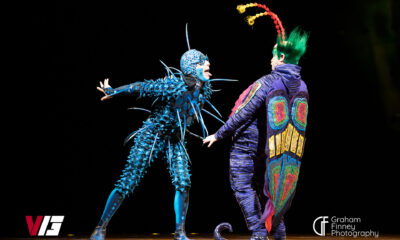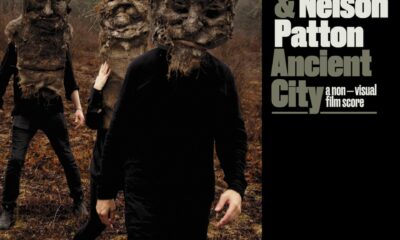Album Review
Charlie Cawood – “Blurring Into Motion” [Album Review]
In more ways than one, Charlie Cawood’s second solo album, Blurring into Motion (Bad Elephant Music), is a charming and engaging trip through contemporary folk and classical traditions.

British multi-instrumentalist Charlie Cawood is the most talented composer you’ve never heard of. According to Wikipedia he can turn his hand to at least 20 different instruments, and is in or has worked with a similar number of musical groups. Prodigious as those figures are, it’s his solo work that’s making his name more widely and deservedly famous. Blurring into Motion is his second solo album.
And no, before you ask, he didn’t perform every instrument on the album. Just as he did on his first album The Divine Abstract, he composed all the music, and plays the various guitar parts: bass, acoustic, and electric. The other 16 instruments, to which he could probably turn his talents, are played instead by a select group of musicians. It isn’t quite a full chamber orchestra, but the music on display is so beautiful, so richly layered and complex that any contemporary classical musician worth their salt would jump at the chance to join his ensemble.
So what exactly is the music? Hyperbole aside, it’s hard to put into a single genre box – as is almost all the best music. At the time of writing, iTunes has him listed as “classical crossover,” a vague description implying classical music mixed with a lot of other things. As with a lot of genre labels, it’s a hat that just about fits. Labels aside, it’s a wonderfully engaging mix of the experimental nature of prog, the joyful bounce of contemporary folk, and the primal nature of medieval folk, blended together with the traditions of classical music in an electrifying, psychedelic fashion. Imagine that the Mediaeval Baebes (for whom Cawood is the principal instrumentalist) and Bellowhead got together with Ian Anderson of Jethro Tull and made a record. For a succinct visual representation of the album’s feel, look at the album artwork from Mark Buckingham, famous for his work on Neil Gaiman’s Sandman comics and Bill Willingham’s Fables series: symbols of nature in harmony blend and blur together as one. Nature itself is literally blurring into motion.
Take, for example, the gentle opener “Dance of Time.” Opening with Cawood strumming gently on the guitar, it feels a little like “Morning Mood” from Edvard Grieg’s famous work Peer Gynt, especially when the flute line comes in. Piano trills appear like morning birdsong, and the rest of the orchestra comes in to conjure an image of dancers celebrating the dawn as it awakens over the English countryside. As the instrumental layers and motifs thread together, the piece maintains a relatively steady tempo, and the whole thing becomes, in so many words, a potted symphony of nature coming alive.
All the songs on the album are folk-symphonies, in their own way. Motifs repeat themselves, and instrumental layers play across each other, building up and falling away in an enchanting dance. “A Severed Circle,” for example, treats us to the slow build of violin over piano, and as the music slowly gathers pace, the melody dances from the woodwind section back to the strings while the brass and percussion keep it grounded, just as one might hear in the classical music of Beethoven or Mozart. On a couple of songs, “Falling Into Blue” and “Flicker Into Being,” listeners are even treated to the arresting voice of Marjana Semkana, who also helped write those two tracks, her lyrics accompanied by charming melodies on both songs.
Despite Cawood working for seven years to bring everything together for The Divine Abstract and only three months to orchestrate Blurring Into Motion, there is no difference in quality at all: both are superb. Whereas predecessor The Divine Abstract had more of an emphasis on the classical traditions of music from India and China, blended with contemporary European classical compositions, Blurring Into Motion feels much closer to home. It feels, for lack of a better term, “British.” It feels like a picnic on a summer’s day in the Lake District, if said picnic was laced with a small amount of LSD: not enough to open your third eye so wide that you behold the wonders of the cosmos through the layers of a jam sandwich, but just enough to make for a very pleasant trip through the awakened consciousness of the English countryside.
Check out the album’s title track:
You might be wondering why I’m being so effusive in my praise. I grew up playing music like this – I played the trombone between the ages of 8 and 18 because I’m effortlessly cool like that. Any album of any kind of music is a complex thing to pull off for any group of musicians. It’s as hard to be one guy and his guitar as it is to be a death metal group as it is to be a blues trio. But classical music, even “classical crossover,” is even more complex again. It’s not a group of people jamming together until an album appears. Classical music, as Cawood demonstrates, is one person writing for a whole group. In the works of composers like Beethoven, it’s upwards of 40 musicians. That’s one person, writing out 3 or 4 pages of music for every instrument in that group.
Classical music in the era we tend to think of as “classical,” i.e. the time of Beethoven and Mozart, was primarily the reserve of the aristocratic elite. Even now, it can be seen as stuffy, posh, or worse: boring. Cawood’s work is none of those things. It is immediately accessible, even to the ears of this reviewer, whose taste in classical stops in the late 1800s. Beyond that, it is just as complex and just as engaging as anything the famous classical composers created. And that’s what’s so refreshing about Cawood. By merging prog and folk with classical notions, he has updated and revitalised classical music for the 21st Century. What more could we ask for?
Well, perhaps one thing: more. Somehow, the album’s 52-minute run-time absolutely rockets past. If you’re not paying attention, it’s over and done with before you know it, like a really good cup of tea drunk absent-mindedly. What this ultimately means is that the album is worth the listener’s full attention. Either with a good set of speakers or a very good pair of headphones, set aside an hour (tea and sandwiches optional but recommended) in your day and really listen. Really try and take in the way the instruments harmonise in the bass section and bounce off each other in the melodic parts.
Overall, Blurring Into Motion is a rich, complex album, layered with enchanting folk motifs and engaging instrumentation. It deserves nothing less than your full attention. It’s both a testament to the sticking power of classical music, rendered intimately accessible by Charlie Cawood’s compositional talents, and a fantastic exhibition of said talents. Cawood should be very proud of this album, and it would be a gross injustice if it doesn’t appear high or at the top of end-of-year lists.
Blurring into Motion Track Listing:
01. Dance Of Time
02. The Stars Turn
03. Falling Into Blue
04. Abyss Of Memory
05. The Dark Within
06. Blurring Into Motion
07. From Pure Air
08. A Severed Circle
09. The False Mirror
10. Flicker Out Of Being
11. Between Two Worlds
12. Void Of Space
Run Time: 52 minutes
Release Date: September 6, 2019
Record Label: Bad Elephant Music
-

 Hardcore/Punk7 days ago
Hardcore/Punk7 days agoHastings Beat Punks Kid Kapichi Vent Their Frustrations at Leeds Beckett University [Photos]
-

 Alternative/Rock6 days ago
Alternative/Rock6 days agoA Rejuvenated Dream State are ‘Still Dreaming’ as They Bounce Into Manchester YES [Photos]
-

 Culture1 week ago
Culture1 week agoCirque Du Soleil OVO Takes Leeds Fans on a Unique, Unforgettable Journey [Photos]
-

 Music23 hours ago
Music23 hours agoReclusive Producer Stumbleine Premieres Beat-Driven New Single “Cinderhaze”
-

 Indie1 week ago
Indie1 week agoMichele Ducci Premieres Bouncy New Single “You Lay the Path by Walking on it”
-

 Culture2 days ago
Culture2 days agoDan Carter & George Miller Chat Foodinati Live, Heavy Metal Charities and Pre-Gig Meals
-

 Alternative/Rock1 week ago
Alternative/Rock1 week agoWilliam Edward Thompson Premieres His Stripped-Down “Sleep Test” Music Video
-

 Country1 week ago
Country1 week agoJayce Turley Reflects on “Misery” with the Premiere of His New Single













